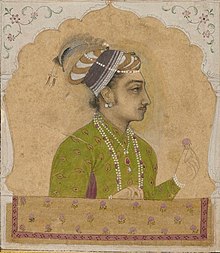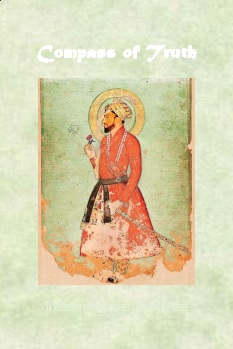|
TRANSLATE THIS ARTICLE
Integral World: Exploring Theories of Everything
An independent forum for a critical discussion of the integral philosophy of Ken Wilber
 David Christopher Lane, Ph.D.
Professor of Philosophy, Mt. San Antonio College Lecturer in Religious Studies, California State University, Long Beach Author of Exposing Cults: When the Skeptical Mind Confronts the Mystical (New York and London: Garland Publishers, 1994) and The Radhasoami Tradition: A Critical History of Guru Succession (New York and London: Garland Publishers, 1992). David Christopher Lane, Ph.D.
Professor of Philosophy, Mt. San Antonio College Lecturer in Religious Studies, California State University, Long Beach Author of Exposing Cults: When the Skeptical Mind Confronts the Mystical (New York and London: Garland Publishers, 1994) and The Radhasoami Tradition: A Critical History of Guru Succession (New York and London: Garland Publishers, 1992).Prince Dara Shikoh's “Compass of Truth”David LaneINTRODUCTIONThe ancient meditative practice of listening to subtle inner sounds has a long history, dating back to the pre-Vedic period in India. However, it is only in the past six to seven hundred years in India that shabd or nad yoga has become more widely known and adopted as a primary method for eliciting higher states of consciousness, with the stated goal of experiencing oneness with the Transcendent Being.[1] The ancient Sanskrit text, Nadabindu Upanishad provides salient details on how the practice is performed, setting up the basis for later iterations of the yogic technique: 31. The Yogin being in the Siddhasana (posture) and practising the Vaishnavi-Mudra, should always hear the internal sound through the right ear. 32. The sound which he thus practises makes him deaf to all external sounds. Having overcome all obstacles, he enters the Turya state within fifteen days. 33. In the beginning of his practice, he hears many loud sounds. They gradually increase in pitch and are heard more and more subtly. 34. At first, the sounds are like those proceeding from the ocean, clouds, kettle-drum and cataracts; in the middle (stage) those proceeding from Mardala (a musical instrument), bell and horn. 35. At the last stage, those proceeding from tinkling bells, flute, Vina (a musical instrument) and bees. Thus he hears many such sounds more and more subtle. 36. When he comes to that stage when the sound of the great kettle-drum is being heard, he should try to distinguish only sounds more and more subtle. 37. He may change his concentration from the gross sound to the subtle, or from the subtle to the gross, but he should not allow his mind to be diverted from them towards others. 38. The mind having at first concentrated itself on any one sound fixes firmly to that and is absorbed in it. 39. It (the mind) becoming insensible to the external impressions, becomes one with the sound as milk with water and then becomes rapidly absorbed in Chidakasa (the Akasa where Chit prevails). 40. Being indifferent towards all objects, the Yogin having controlled his passions, should by continual practice concentrate his attention upon the sound which destroys the mind. 41. Having abandoned all thoughts and being freed from all actions, he should always concentrate his attention on the sound and (then) his Chitta becomes absorbed in it.”[2] Many centuries later, the famous 15th century text, Hatha Yoga Pradipika, explained what sounds are preliminary and which are more advanced: In the first stage, the sounds are surging, thundering like the beating of kettle drums and jingling ones. In the intermediate stage, they are like those produced by conch, Mridanga, bells, etc. Even Western based religious traditions, particularly the gnostic schools, have mentioned listening to a divine melody which lifts the soul up to higher regions. As Dr. Andrea Diem, Professor of Philosophy at Mt. San Antonio College, elaborates, In the Trimorphic Protennoia it is described in the following way: Sufism, in particular, has expounded on the efficacy of listening to the inner sound current as a way to control the wayward mind. Several Islamic mystics, including Rumi, have spoken at length about hearing heavenly sounds while in deep contemplation. It is an intriguing historical question to ponder on how meditating on subtler and subtler sounds first became known and advocated among spiritual adepts. Arguably, the practice may have arisen in our prehistoric past since any form of deep concentration (by whatever means or by happenstance) tends to make one more keenly aware and cognizant of hidden features within one's own consciousness and neurophysiology.  Dara Shikoh c.1640 One of the more interesting works on this subject comes from the pen of Dara Shikoh[4], the eldest son of Shah Jahan, the great Mogul emperor who built the wondrous Taj Mahal in Agra, India. After securing initiation from his spiritual guide, Mulla Shah Badakhsi, in Kashmir, Dara Shikoh wrote a short, but revealing text in Persian entitled Risâla-yi Haqq Numâon (“The Compass of Truth”). Here he openly revealed what had usually been a closely guarded secret among Sufi masters: how to properly use breathing exercises, holy repetition, focused awareness, and listening to the sound current in order to free the petty mind from unnecessary distractions and experience a majestic unity with the Divine. As Doha Tazi Hemida, a graduate student at Columbia University, explains in her brilliant essay, "A Hindu-Islamic Translation: Retrieving Dârâ Shikûh's Confuence of the Two Oceans", This was followed by Risâla-yi Haqq Numâ (“The Compass of Truth”) in 1646, which marked a significant turning point. Again, he declared to have been divinely inspired to unveil the truths of Sufism for novices and uninitiated disciples, as a pir to a murid. In his introduction, he already speaks of the divine unity present in all religions, including Hinduism, and articulates the different stages a Sufi ought to go through: annihilation of self (fanâ'), intoxication of union (sukr al-jam'), and ultimately “Unity in Plurality” (wâhidiyya). To pass away with the “small self” is to realize that ontologically nothing exists except God—this is Ibn Arabi's wahdat al-wujûd or Unity of Existence. Such a realization leads one to see that “there are as many ways to God as there are seekers of Him”: wâhidiyya is to realize that the many are identical in essence with each other and with the divine reality. Dara Shikoh was by all accounts a remarkable scholar, even if he lacked the military prowess necessary to succeed his father, Shah Jahan, as Mogul Emperor. He was fluent in several languages and had a keen interest in spirituality across traditions, foregoing the strident parochialism and narrow-mindedness of more literally minded followers of Islam. Historically, the tragedy that still haunts India till this day is that Dara Shikoh was never able to succeed his father as heir apparent since his younger brother Aurangzeb ordered his execution and beheading so that he could succeed to the throne which he did in 1658, declaring that his older brother, Dara Shikoh, was as an apostate. Nevertheless, Dara Shikoh has had an outsized influence because of his remarkable writings and for the tolerance he showed to religious expressions differing from his own. The following short text, which was titled with the distinctive spelling of Risa La-i-Haq-Numa (“The Compass of Truth”) was first rendered into English in 1912 by Rai Bahadur Srisa Chandra Vasu, who was a member of the Islamia Lodge Theosophical Society in Benares, The book was published by the Panini Office at the Bhuvaneswari Asrama, Bahadurganj, in Allahabad, India. A later translation was made by Scott Kugle, Professor of South Asian and Islamic Studies at Emory University, in 2012, and published in the book Sufi Meditation and Contemplation (New Lebanon, Suluk Press). Although we have only utilized Vasu's translation for this book (because it is now in the public domain and no longer copyrighted by the original publisher), it is important to note that Professor Kugle's more recent translation differs at various points. He gives one illustrative example in his book Sufi Meditation and Contemplation, “I appreciate the effort that Srisa Chandra Vasu put into translating The Compass of Truth, yet I did not rely upon his translation but rather went back to the Persian original in order to create a new translation that will be useful to modern readers. But for clarity, I should alert reader to just how this new translation differs from that done a century earlier. Here is an example of how my translation differs from the earlier English translation. Vasu wrote, While I can readily acknowledge Professor Kugle's criticism of Vasu's earlier translation, the fact remains that the essential import concerning the sound current meditation, as espoused by Dara Shikoh, remains the same. I think what I find most remarkable about The Compass of Truth is how open and transparent Dara Shikoh was in expressing how an erstwhile secret Sufi meditational practice is performed. His elucidation of how to listen to the inner sound and why it is more efficacious than other techniques can be best summarized by one very telling and observant line which Professor Kugle translates thusly: “There is no practice better than that of hearing this sound. This is because every other practice depends upon the will of the practitioner; if for a moment stops it, the practice ceases. But not so this practice! It does not depend upon the will of the practitioner. It is present and available without ceasing and without interruption at all times.” As a historian of shabd yoga related practices, I am fascinated to know that one of the great personages of the 17th century expounded in detail about listening to the inner sound and made the hidden practice more widely known. It is particularly interesting to note that two centuries later, this same meditational technique would form the rudimentary basis of a new religious movement in the same city where the magnificent Taj Mahal was built and where Dara Shikoh's father was tragically imprisoned by his younger son, Aurangzeb. That movement, founded by Shiv Dayal Singh (1818-1878) living on an obscure street called Panni Gali, in Agra, would eventually become known worldwide as Radhasoami.[6] It makes one wonder whether shabd or nad yoga in the guise of Sultan-ul-Azkar as taught by Sufi masters such as Baba Sain Mir Mohammed Sahib and Mullah Shah (key mentors in Dara Shikoh's life) was not responsible for a certain kind of mystic zeitgeist in Agra which made listening to the inner sound a more attractive and viable option to those searching for a beneficial spiritual practice. One thing is certain, however, Prince Dar Shikoh's life, though cut brutally short (his brother had his decapitated head sent to their father in a box, while he was imprisoned in the large Agra Fort) continues to have a significant influence through his numerous writings which touch at the very core of spirituality and which give hope to all those seeking for a deeper meaning to life and who are reaching out for better ways to probe the innermost reaches of their own consciousness and being. NOTES[1] See the book, Listening to the Inner Sound: The Perennial Practice of Shabd Yoga (Walnut, Mt. San Antonio College, 2018) for a more detailed analysis and history of this meditational technique. [2] For a fuller excerpt of Hatha Yoga Prakipika and the Nadabindu Upanishad, see Shabd Yoga: Esoterica from the East (Walnut: Mt. San Antonio College, 2018) [3] See The Gnostic Mystery: A Connection Between Ancience and Modern Mysticism (Walnut: Mt. San Antonio College, 2015). [4] There are variant spellings given for Shikoh, ranging from “Shikuh” to the diacritically proper “Dârâ Shikôh” [5] Pages 127 to 128, Sufi Meditation and Contemplation. [6] For more information on the history of Radhasoami, see Mark Juergensmeyer's Radhasoami Reality (Princeton: Princeton University Press, 1991).
Comment Form is loading comments...
|
